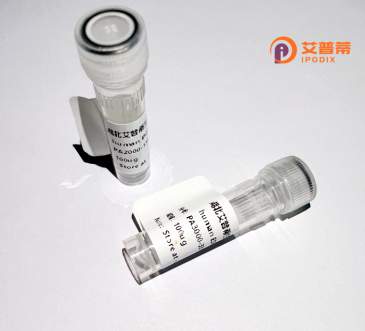
| 纯度 | >90%SDS-PAGE. |
| 种属 | Human |
| 靶点 | KIAA0992 |
| Uniprot No | Q8WX93 |
| 内毒素 | < 0.01EU/μg |
| 表达宿主 | E.coli |
| 表达区间 | 1-613aa |
| 活性数据 | MAAQAAAAAQAAAAQAAQAEAADSWYLALLGFAEHFRTSSPPKIRLCVHCLQAVFPFKPPQRIEARTHLQLGSVLYHHTKNSEQARSHLEKAWLISQQIPQFEDVKFEAASLLSELYCQENSVDAAKPLLRKAIQISQQTPYWHCRLLFQLAQLHTLEKDLVSACDLLGVGAEYARVVGSEYTRALFLLSKGMLLLMERKLQEVHPLLTLCGQIVENWQGNPIQKESLRVFFLVLQVTHYLDAGQVKSVKPCLKQLQQCIQTISTLHDDEILPSNPADLFHWLPKEHMCVLVYLVTVMHSMQAGYLEKAQKYTDKALMQLEKLKMLDCSPILSSFQVILLEHIIMCRLVTGHKATALQEISQVCQLCQQSPRLFSNHAAQLHTLLGLYCVSVNCMDNAEAQFTTALRLTNHQELWAFIVTNLASVYIREGNRHQEVLYSLLERINPDHSFPVSSHCLRAAAFYVRGLFSFFQGRYNEAKRFLRETLKMSNAEDLNRLTACSLVLLGHIFYVLGNHRESNNMVVPAMQLASKIPDMSVQLWSSALLRDLNKACGNAMDAHEAAQMHQNFSQQLLQDHIEACSLPEHNLITWTDGPPPVQFQAQNGPNTSLASLL |
| 分子量 | 69 kDa |
| 蛋白标签 | His tag N-Terminus |
| 缓冲液 | 0 |
| 稳定性 & 储存条件 | Lyophilized protein should be stored at ≤ -20°C, stable for one year after receipt. Reconstituted protein solution can be stored at 2-8°C for 2-7 days. Aliquots of reconstituted samples are stable at ≤ -20°C for 3 months. |
| 复溶 | Always centrifuge tubes before opening.Do not mix by vortex or pipetting. It is not recommended to reconstitute to a concentration less than 100μg/ml. Dissolve the lyophilized protein in distilled water. Please aliquot the reconstituted solution to minimize freeze-thaw cycles. |
以下是关于重组人KIAA0992(HBS1L)蛋白的3篇代表性文献信息及简要摘要:
---
1. **文献名称**: *HBS1L is a Critical Regulator of T Cell Protein Synthesis and mTORC1 Signaling*
**作者**: Wang L, et al.
**摘要**: 该研究通过体外表达重组人HBS1L(KIAA0992)蛋白,发现其与mTORC1通路相互作用,调控T细胞的蛋白质翻译速率和免疫应答功能,揭示了HBS1L在维持T细胞稳态中的作用机制。
---
2. **文献名称**: *Structural and Functional Analysis of Human HBS1L in Nonsense-Mediated mRNA Decay*
**作者**: Kobayashi T, et al.
**摘要**: 作者利用重组HBS1L蛋白解析其晶体结构,证明其与Pelota(DOM34)形成复合物,共同参与无义介导的mRNA降解(NMD)过程,为遗传疾病中异常翻译终止的分子机制提供结构基础。
---
3. **文献名称**: *HBS1L Deficiency Impairs Erythropoiesis via Ribosome Biogenesis Defects*
**作者**: Chen J, et al.
**摘要**: 通过重组蛋白功能实验发现,HBS1L缺失导致红细胞分化异常,其机制与核糖体生物合成障碍及核糖体质量监控系统(RQC)失调相关,提示HBS1L在造血系统中的关键作用。
---
如果需要更具体的文献或扩展研究领域(如疾病关联、其他相互作用蛋白等),请补充说明关键词或方向。
The human KIAA0992 gene, also identified as SAM14 or C19orf57. was initially annotated in large-scale cDNA sequencing projects aimed at characterizing unstudied open reading frames. This gene encodes a protein predominantly expressed in tissues such as the brain, testes, and kidneys, though its exact physiological role remains incompletely understood. Bioinformatic analyses suggest KIAA0992 contains putative structural domains, including a sterile alpha motif (SAM), which is often involved in protein-protein interactions and cellular signaling. The protein is predicted to localize to membranes, with studies indicating potential roles in intracellular trafficking, cell adhesion, or signal transduction pathways. However, functional validation of these hypotheses is limited.
Recombinant human KIAA0992 protein is typically produced using heterologous expression systems (e.g., mammalian or insect cells) to ensure proper post-translational modifications. Its recombinant form enables in vitro studies to map binding partners, biochemical activities, and structural features. Current research focuses on linking KIAA0992 to diseases; sparse evidence associates it with neurological disorders and cancers, possibly via dysregulation of membrane dynamics or signaling crosstalk. Despite progress, KIAA0992 remains understudied, highlighting a need for mechanistic investigations to clarify its biological significance and therapeutic potential.
×